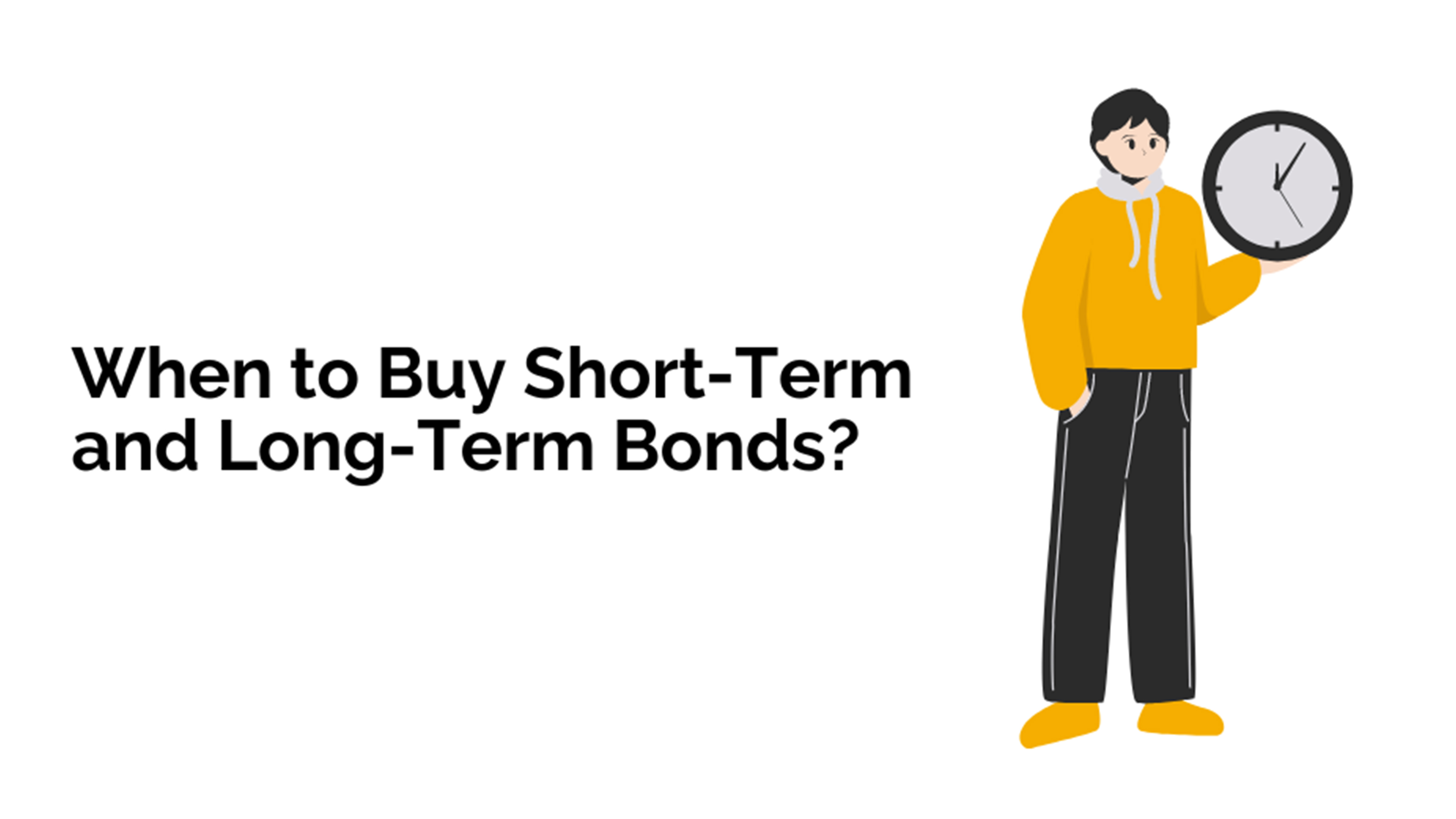When to Buy Short-Term and Long-Term Bonds

If you are looking for safe investments, you can try investing in bonds, as they offer capital protection. Along with capital protection, bonds also help you earn a return on your invested capital.
The return you earn by investing in bonds is known as the yield. Among other things, your yield may differ based on the maturity period of the bond. This relationship between yield and maturity term is represented by the yield curve.
In this article, you will learn about short-term bonds and long-term bonds and when you can buy them.
But before that, it is important to understand the yield curve and how it behaves in different economic situations.
What you need to know about the Yield Curve?
A yield curve is a graphical representation where the yield or the interest rate is on the X-axis, and the maturity term is on the Y-axis. Simply put, the yield curve shows the return you will earn if you invest in a bond for a given period. Since the bond yield and maturity term are positively related, the yield curve is upward-sloping.
However, the yield curve's shape can change according to market forces and the prevailing economic situation.
Broadly, there are three types of yield curves. Let's explore them in detail:
1. Normal Yield Curve
The normal yield curve has an upward slope. It follows the simple rationale that if you invest in a long-term bond, you expect a relatively higher interest. Long-term bonds carry more risks, such as a potential rise in inflation or interest rates. These risks will impact your investment, for which you need to be compensated.
2. Inverted Yield Curve
The yield curve takes an inverted shape when yields on long-term bonds are lower than on short-term bonds.
This happens due to two factors:
a. When long bond investors anticipate the future rate of interest to decline, they buy more long-term bonds, causing their price to rise. As you know, bond prices are inversely related to yield,the long term bond yield declines.
b. When investors sell their short-term bond holdings to buy more long-term bonds, the price of short-term bonds falls, resulting in an increase in their yield.
3. Flat Yield Curve
We see a flat yield curve when the shape of the yield curve changes from normal to inverted or vice versa. It is a transitional period where yields from long-term and short-term bonds are similar. In this situation, investors have no incentive to take on more risk and buy long-term bonds.
With an understanding of the yield curve and its types, we can now examine the different economic situations, such as inflation, economic growth, and recession, that impact the yield curve.
Let's analyse each of these three situations briefly:
1. Inflation
An increase in inflation negatively affects the present value of all future cash flows (or returns) from bond investments, thus reducing the total income for the investor. To compensate for this loss in income, bond issuers offer higher yields on long-term bonds. Hence, an increase in inflation signals a rise in the future rate of interest.
2. Economic Growth
Economic growth refers to a rise in overall economic activity. In such a situation, more and more capital is required to fuel economic growth. This leads to higher competition for available capital. Bond investors have more options. This leads to an increase in yield.
3. Recession
A recession is when economic activities fall, leading to a loss in production and employment. With a bleak future in sight, investors generally prefer investing in long-term government bonds with almost no default risk. This leads to a rise in demand and a fall in the price of government bonds. Since bond price and yield are inversely related, the bond yield falls in a recession.
Short-Term vs Long-Term Bonds: Which Should You Choose?
When you invest in bonds, you lend your money to the government or a company. In return, they promise to pay you back with interest after a certain time. This period is called the bond’s maturity. In India, bonds are typically classified by maturity: short-term (under 3 years), medium-term (3–10 years), and long-term (10+ years). This classification helps investors align their investments with financial goals and risk tolerance.
Understanding these types of bonds is crucial in determining which one aligns better with your financial goals.
What are Short-Term Bonds? (Maturities under 3 years)
Short-term bonds are bonds that mature or pay back their full amount in less than three years. They are considered low-risk investments because you get your money back quickly, and interest rate changes have less impact on them. They are ideal for investors who want to park funds safely for short-term goals such as purchasing a car, making a down payment, or building an emergency corpus
For example, if you invest in a 2-year government bond and the interest is 6%, you’ll get fixed payments and your full money back at the end of 2 years, regardless of market changes.
What are Long-Term Bonds? (Maturities 10+ years)
Long-term bonds usually have a maturity of 10 years or more. They offer higher returns because your money stays invested for a longer time. But they are also more sensitive to interest rate changes. If interest rates rise after you buy a long-term bond, the value of your bond may drop if you try to sell it before maturity.
These are ideal if you don’t need your money soon, like planning for retirement in 15 or 20 years. For example, if you invest in a 20-year corporate bond with an 8% interest rate, you’ll earn that rate every year until maturity, but be prepared for more ups and downs in value along the way.
Key Factors That Influence Bond Selection
Choosing between short-term and long-term bonds depends on several important factors. Here are the key things you should consider before making your decision:
- Investment Horizon: If you need your money back soon (within 1–3 years), short-term bonds are better. If you’re investing for long-term goals like retirement, long-term bonds may be more suitable.
- Interest Rate Outlook: If interest rates are expected to rise, short-term bonds are safer since they are less sensitive to changes. If rates are likely to fall, long-term bonds can lock in higher returns.
- Risk Tolerance: Long-term bonds carry more interest rate risk, meaning their value can go down if rates rise. Short-term bonds are more stable but offer lower returns.
- Income Needs: Long-term bonds generally pay higher interest (called yield) over time. If you need a steady income, these can help. However, if your focus is on liquidity and safety, a short-term approach may be better.
- Market Liquidity: Short-term bonds are usually easier to sell quickly without losing value. This matters if you may need quick access to your money.
- Credit Risk: Corporate long-term bonds can carry higher default risk compared to short-term government bonds. Always check the bond rating before investing.
Understanding these factors helps you select bonds that align with your financial goals and risk tolerance.
When to Buy Short-Term Bonds
Short-term bonds are best when interest rates are rising or expected to go up soon. Since these bonds mature quickly—usually within 1 to 3 years—they allow you to reinvest your money at higher rates later. They are also a good choice when you want to keep your capital safe and need the money in the near future, like for a vacation, house down payment, or emergency fund. Because short-term bonds are less sensitive to market changes, they help reduce risk while offering steady, though lower, returns. They are ideal for conservative investors looking for stability and liquidity.
When to Buy Long-Term Bonds
Long-term bonds are a smart choice when interest rates are stable or expected to fall. In such times, locking in a higher interest rate for a longer period ensures steady income over the years. These bonds are ideal for long-term financial goals, such as retirement planning or funding a child’s education. While they carry higher interest rate risk, they typically offer better returns than short-term bonds. If you don’t plan to sell the bond before maturity and are comfortable with market ups and downs, long-term bonds can help you grow your wealth with predictable earnings over time.
To summarise
Bonds are a great investment vehicle to prevent capital losses. While bonds issued by the government carry little to no default risk, corporate bonds are low-risk investment options. You can analyse the risk of a bond investment by looking at the yield curve and factors that influence its movement.
As an investor, you may buy long-term bonds when you anticipate the interest rate to fall and vice versa. However, the best possible way may be to buy bonds and hold them till maturity.
Frequently Asked Questions
1. What is the main difference between short-term and long-term bonds?
Short-term bonds mature in less than 3 years, offering lower risk and quicker access to funds. Long-term bonds mature in 10+ years and offer higher returns but come with more interest rate risk.
2. Which is safer: short-term or long-term bonds?
Short-term bonds are generally safer due to their lower sensitivity to interest rate fluctuations and shorter holding period.
3. When should I invest in long-term bonds in India?
Long-term bonds are best during stable or falling interest rates and for long-term goals like retirement or children’s education.
